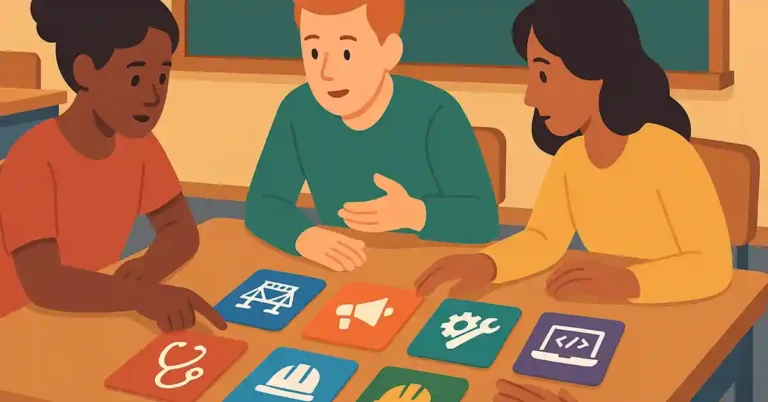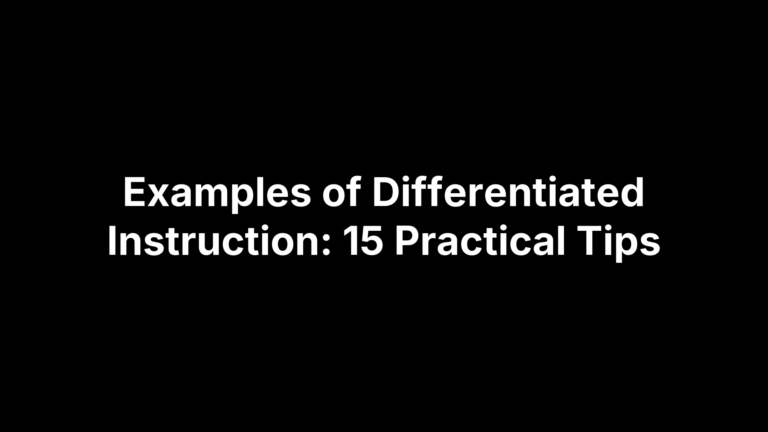Advantages of Self-Paced Modules in Differentiated Classrooms
In the ever-evolving world of education, I’ve observed a multitude of pedagogical trends come and go. However, certain concepts, when fused, can revolutionize the learning environment for students. Two such ideas are the self-paced modules and differentiated classrooms. Allow me to take you on a journey through these innovative concepts and illuminate the transformative potential they hold for our classrooms.
Self-Paced Modules: When I first encountered this term, it struck a chord with my own educational experiences. At its core, a self-paced module is a learning unit where students progress at their own speed. Gone are the days where everyone is expected to grasp a concept at the exact same pace. Instead, these modules acknowledge and respect that each learner is unique. Some may breeze through a topic they find intuitive, while others may need more time to delve deep, ruminate, and truly understand. And isn’t that what true learning is about? It’s not a race, but a journey of discovery, where the pace of travel is tailored to the individual’s needs.
Differentiated Classrooms: On the other hand, the term ‘differentiated classrooms’ is like music to my ears. Picture a classroom where each student’s uniqueness isn’t just tolerated but celebrated. In such an environment, instruction is tailored to meet individual needs—whether those needs stem from different learning styles, varying backgrounds, or distinct levels of readiness. As an educator, it’s a vision I’ve always aspired to realize: a place where every student feels seen, understood, and valued.
When these two concepts come together, the magic truly begins. Imagine a classroom humming with activity: one corner has a group engaged in a spirited discussion, another has students with headphones immersed in interactive digital content, while yet another has a student deep in thought, scribbling down ideas in a journal. All are learning the same core concepts, but each is doing so in a way that resonates with their personal learning style and at a pace that ensures genuine comprehension.
The Rationale Behind Differentiation in Education
Throughout my years in education, I’ve come to a profound realization: if we genuinely aim to uplift every student, we must understand and respect their individuality.
Addressing Individual Learning Needs: Every student walks into the classroom with a unique set of experiences, capabilities, and challenges. Some may grasp mathematical concepts in a heartbeat, while others shine in linguistic capabilities. Differentiation acknowledges this diversity. Instead of providing a one-size-fits-all approach, it emphasizes meeting students where they stand. It’s akin to providing each student with a bespoke educational suit tailored precisely to their measurements.
Cultivating a Classroom Environment that Nurtures Every Student’s Potential: A differentiated classroom transforms from a space of mere instruction to a haven of growth and exploration. Here, students don’t just learn; they thrive. It is a place where barriers are replaced with bridges, allowing every student to cross over to the realms of understanding and passion.
Advantages of Integrating Self-Paced Modules

Pairing the concept of differentiation with self-paced modules opens up a world of benefits. Here are a few that I’ve observed and celebrated:
Personalized Learning Paths
Adapting to Student’s Strengths and Weaknesses: No longer do students have to conform to a fixed curriculum. With self-paced modules, curriculums adapt to students. Those areas that a student finds challenging get the attention they deserve, and their strengths are further honed and advanced.
Accommodating Diverse Learning Styles: Some students are visual learners; others resonate more with auditory or kinesthetic methods. Self-paced modules can cater to these preferences, ensuring that every student has the best tools for their unique learning journey.
Enhanced Student Engagement
Meeting Students Where They Are: The beauty of self-paced learning is its innate respect for the student’s current level. This ensures that no one feels overwhelmed or, conversely, under-challenged.
Providing Relevant and Compelling Content Tailored to Their Pace: When content resonates with a student’s curiosity and aligns with their pace, engagement is a natural outcome.
Increased Responsibility and Autonomy
Fostering Independence in Learning: Self-paced modules empower students to take the reins of their education. They decide the speed, the depth, and the direction of their learning journey.
Encouraging Self-directed Study Habits: With autonomy comes the responsibility of shaping one’s study habits. This fosters a proactive approach to learning, where students seek knowledge rather than merely receiving it.
Flexibility in Instruction
Easier Curriculum Adjustments: The digital nature of many self-paced modules allows for swift and seamless adjustments in the curriculum. If a particular topic or method isn’t resonating, it can be modified in real-time.
Catering to the Needs of Both Fast and Slow Learners: This ensures that every student, regardless of their learning speed, feels seen, valued, and catered to.
Promotes Continuous Feedback and Reflection
Real-time Assessments and Adjustments: Continuous feedback mechanisms in self-paced modules ensure that students are always aware of their progress and areas of improvement.
Encourages Self-reflection and Growth Mindset: As students navigate these modules, they’re constantly prompted to reflect on their understanding, fostering a mindset that views challenges as opportunities for growth.
Potential Challenges and Solutions

As with any innovation in education, the integration of self-paced modules in differentiated classrooms isn’t devoid of challenges. However, these challenges, when approached with discernment and proactivity, can lead to more robust, resilient educational frameworks. Let’s explore some of these potential hurdles and the solutions that can guide us forward.
Ensuring Equity and Managing Diverse Progress Rates
One of the immediate concerns that arise with self-paced modules is the disparity in progress rates. While the essence of self-paced learning is to allow students to move at their own speed, it can sometimes lead to significant disparities where some students move far ahead, and others lag considerably.
Solution: One approach is to have periodic “synchronization points” in the curriculum. These are junctures where all students come together for group activities, discussions, or projects. This ensures that while students progress individually, they still share collective learning experiences, fostering a sense of community. Moreover, for those who might need extra support, specialized mentoring sessions or peer-tutoring can be integrated to ensure no one feels left behind.
Maintaining Quality and Consistency
The very nature of differentiation and self-paced modules means that students might be accessing different resources at different times. This can pose a challenge in ensuring that all students receive a consistent quality of education.
Solution: Implementing a robust review mechanism is vital. All self-paced modules should undergo rigorous quality checks before being made available to students. Additionally, real-time feedback mechanisms can be integrated within these modules, allowing educators to receive immediate insights into areas that might need improvement. Furthermore, educators can undergo periodic training sessions to ensure they are well-equipped to guide students through diverse learning paths while maintaining a uniform standard of excellence.
Another critical aspect is to incorporate regular assessments, not just for grading but to gauge the effectiveness of the modules. If certain modules consistently result in lower comprehension or engagement rates, they can be flagged for review and refinement.
Tools and Resources for Implementing Self-Paced Modules

The push towards self-paced modules in differentiated classrooms has, fortunately, been mirrored by a rise in tools and platforms designed specifically to cater to this evolving need. The myriad of available resources might feel overwhelming at first, but when chosen wisely, they can become indispensable assets in the educational journey. Let’s delve into some of the most reputable platforms and tools, and how they can be aligned with various educational needs.
Overview of Popular Platforms and Resources
Khan Academy: A pioneer in the realm of online education, Khan Academy offers courses in a plethora of subjects. Its self-paced nature, combined with interactive exercises and instant feedback, makes it a go-to for many educators.
Edmodo: Think of it as a social network for education. Edmodo allows educators to share content, distribute quizzes, assignments, and receive student feedback, all within a controlled, secure environment.
Google Classroom: Integrated with other Google services, Google Classroom offers a seamless platform for creating, distributing, and grading assignments. It’s especially potent when used in tandem with other G Suite tools.
Moodle: An open-source learning platform designed to provide educators, administrators, and learners with a single robust, secure, and integrated system to create personalized learning environments.
Recommendations Based on Different Educational Needs
For Elementary Students: Platforms like Khan Academy and ABCmouse are beneficial due to their interactive and visually engaging content. They simplify complex concepts into bite-sized, enjoyable lessons.
Middle School and High School: Edmodo and Google Classroom can be pivotal. They not only offer content but also provide an organizational structure essential for students as they juggle multiple subjects and assignments.
Advanced Placement (AP) or Specialized Courses: Coursera or Udemy might be a suitable choice. They offer specialized courses from top institutions and experts, which can be especially beneficial for students looking to delve deep into specific subjects.
For Diverse Learning Styles: Moodle, with its open-source flexibility, can be tailored to cater to various learning styles. It allows educators to integrate multimedia content, quizzes, and other resources to cater to auditory, visual, and kinesthetic learners.
Educator Professional Development: Platforms like EdX or Coursera are invaluable. They offer courses on evolving pedagogical strategies, technological tools, and more, ensuring that educators themselves remain lifelong learners.
Conclusion
Reflecting upon our exploration of self-paced modules in differentiated classrooms, it becomes evident that we stand at a pivotal juncture in educational history. The age-old, one-size-fits-all model of education is giving way to more tailored, student-centered approaches. Self-paced modules, with their flexibility and respect for individual learning curves, play an instrumental role in this paradigm shift.
In differentiated classrooms, every student is acknowledged for their uniqueness. Their strengths, challenges, curiosities, and aspirations are not just noted but celebrated and nurtured. Integrating self-paced modules in such an environment further amplifies this ethos. It ensures that students not only have a voice but also have control over their learning journey’s pace and direction.
To my fellow educators and all stakeholders in the realm of education: the tools, resources, and knowledge are at our fingertips. Let’s embrace the transformative potential of self-paced modules in differentiated classrooms. The promise is nothing short of an educational environment where every student feels seen, heard, valued, and empowered. Let’s reimagine, reshape, and revolutionize our classrooms, for in our hands lies the potential to craft a brighter, more inclusive future for our learners.
Further Reading
Khan, S. (2012). The One World Schoolhouse: Education Reimagined. Hodder & Stoughton.
Duckworth, E. (2006). “The having of wonderful ideas” and other essays on teaching and learning. Teachers College Press.






